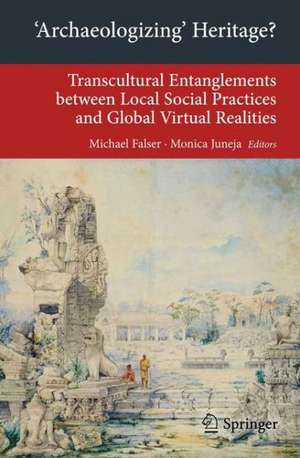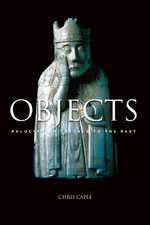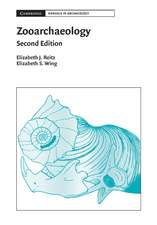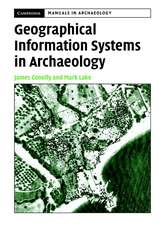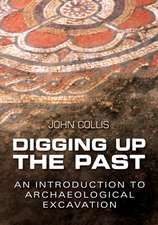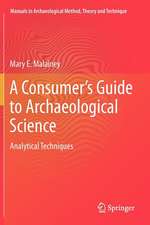'Archaeologizing' Heritage?: Transcultural Entanglements between Local Social Practices and Global Virtual Realities: Transcultural Research – Heidelberg Studies on Asia and Europe in a Global Context
Editat de Michael Falser, Monica Junejaen Limba Engleză Paperback – 11 iun 2013
Case studies from computational modelling in archaeology discuss a comparable paradigmatic change from a mere simulation of supposedly dead archaeological building material to an increasing appreciation and scientific incorporation of the knowledge of local stakeholders. This book seeks to bring these different approaches from the humanities and engineering sciences into a trans-disciplinary discussion.
Din seria Transcultural Research – Heidelberg Studies on Asia and Europe in a Global Context
- 18%
 Preț: 948.92 lei
Preț: 948.92 lei - 18%
 Preț: 1216.48 lei
Preț: 1216.48 lei - 15%
 Preț: 637.59 lei
Preț: 637.59 lei - 15%
 Preț: 636.80 lei
Preț: 636.80 lei - 18%
 Preț: 939.46 lei
Preț: 939.46 lei - 15%
 Preț: 648.24 lei
Preț: 648.24 lei - 15%
 Preț: 639.25 lei
Preț: 639.25 lei - 15%
 Preț: 643.34 lei
Preț: 643.34 lei - 15%
 Preț: 640.55 lei
Preț: 640.55 lei - 15%
 Preț: 649.54 lei
Preț: 649.54 lei -
 Preț: 419.06 lei
Preț: 419.06 lei - 15%
 Preț: 632.52 lei
Preț: 632.52 lei -
 Preț: 386.99 lei
Preț: 386.99 lei - 15%
 Preț: 636.30 lei
Preț: 636.30 lei -
 Preț: 387.75 lei
Preț: 387.75 lei -
 Preț: 363.52 lei
Preț: 363.52 lei - 18%
 Preț: 784.61 lei
Preț: 784.61 lei - 15%
 Preț: 644.18 lei
Preț: 644.18 lei - 18%
 Preț: 897.14 lei
Preț: 897.14 lei - 18%
 Preț: 779.57 lei
Preț: 779.57 lei - 15%
 Preț: 584.10 lei
Preț: 584.10 lei - 15%
 Preț: 588.37 lei
Preț: 588.37 lei
Preț: 889.75 lei
Preț vechi: 1085.06 lei
-18% Nou
Puncte Express: 1335
Preț estimativ în valută:
170.25€ • 178.71$ • 141.31£
170.25€ • 178.71$ • 141.31£
Carte tipărită la comandă
Livrare economică 10-24 aprilie
Preluare comenzi: 021 569.72.76
Specificații
ISBN-13: 9783642358692
ISBN-10: 3642358691
Pagini: 290
Ilustrații: VIII, 287 p. 200 illus., 90 illus. in color.
Dimensiuni: 155 x 235 x 20 mm
Greutate: 0.41 kg
Ediția:2013
Editura: Springer Berlin, Heidelberg
Colecția Springer
Seria Transcultural Research – Heidelberg Studies on Asia and Europe in a Global Context
Locul publicării:Berlin, Heidelberg, Germany
ISBN-10: 3642358691
Pagini: 290
Ilustrații: VIII, 287 p. 200 illus., 90 illus. in color.
Dimensiuni: 155 x 235 x 20 mm
Greutate: 0.41 kg
Ediția:2013
Editura: Springer Berlin, Heidelberg
Colecția Springer
Seria Transcultural Research – Heidelberg Studies on Asia and Europe in a Global Context
Locul publicării:Berlin, Heidelberg, Germany
Public țintă
ResearchCuprins
‘Archaeologizing Heritage’ and Transcultural Entanglements – an Introduction.- Part I: Archaeologizing Heritage I – India between the Manual and the Picturesque.- A Conservation Code for the Colony: John Marshall’s Conservation Manual and Monument Preservation between India and Europe.- Picturesque Authenticity in Early Archaeological Photography.- Part II: Archaeologizing Heritage II – Creating Visual and Spatial Experiences of Angkor.- Virtual Visions of Angkor: Plaster Casts and Drawings in the Indochinese Museum of the Trocadero.- From Colonial Map to Visitor’s Parcours – Tourist Guides and the Spatiotemporal Making of the Archaeological Park of Angkor.- Part III: Virtualizing Heritage I – The Surface and the Image.- Reality–based Virtual Models in Cultural Heritage.- 3D Modelling of Angkor Temple Based on Religious Conception.- Part IV: Virtualizing Heritage II – Computer Models for Building Research.- The Giant Buddha figures in Afghanistan - Virtual Reality for a Physical Reconstruction?.- Virtualizing the Temple of Bayon.- Part V: Restoration and Interpretation – Of Virtual Models and Living Communities.- Between On Site-Conservation and Scientific Computing: A Future for the Twelfth-Century Banteay Chhmar Temple Complex.- Angkor: Preserving World Heritage and the Role of Interpretation.- Developing Conservation Approaches to Living Heritage at Angkor: The Conservation of the Statue of Ta Reach.- Part VI: Memorializing Archaeology – Archaeologizing Memory.- Today's Pagan – Conservation under the Generals.- The Angkorian Palimpsest: The Daily Life of Villagers Living on a World Heritage Site.- The Living Archaeology of a Painful Heritage: The First and Second Life of the Khmer Rouge Mass Graves.
Recenzii
“This book has successfully articulated the theoretical and empirical issues of ‘archaeologizing’ heritage beyond specific time and place; at the same time it stimulates readers to consider the importance of intangible or spiritual and socio-economic dimensions of the ‘living heritage’ approach and reminds us of the existence of a fertile ground for debates on the notion and practice of heritage.” (Keiko Miura, ASEASUK News, Issue 57, 2015)
Textul de pe ultima copertă
This book investigates what has constituted notions of "archaeological heritage" from colonial times to the present. It includes case studies of sites in South and Southeast Asia with a special focus on Angkor, Cambodia. The contributions, the subjects of which range from architectural and intellectual history to historic preservation and restoration, evaluate historical processes spanning two centuries which saw the imagination and production of "dead archaeological ruins" by often overlooking living local, social, and ritual forms of usage on site.
Case studies from computational modelling in archaeology discuss a comparable paradigmatic change from a mere simulation of supposedly dead archaeological building material to an increasing appreciation and scientific incorporation of the knowledge of local stakeholders. This book seeks to bring these different approaches from the humanities and engineering sciences into a trans-disciplinary discussion.
Case studies from computational modelling in archaeology discuss a comparable paradigmatic change from a mere simulation of supposedly dead archaeological building material to an increasing appreciation and scientific incorporation of the knowledge of local stakeholders. This book seeks to bring these different approaches from the humanities and engineering sciences into a trans-disciplinary discussion.
Caracteristici
The first trans-disciplinary insight into the concept of 'archaeological heritage' between architectural and intellectual history, historic preservation and scientific computing A unique compilation of case studies on South and Southeast Asia which covers the world-famous sites of Angkor, Pagan and Bamiyan Offers a wide range of impressive illustrations from different historical and current media an archaeological sites: manuals, drawings, maps, plaster casts, tourist guides, photogrammetric materials and virtual computer models Includes supplementary material: sn.pub/extras
